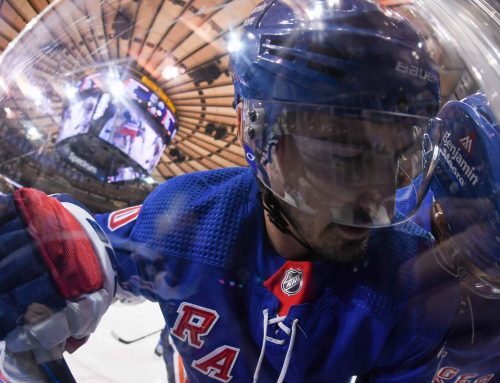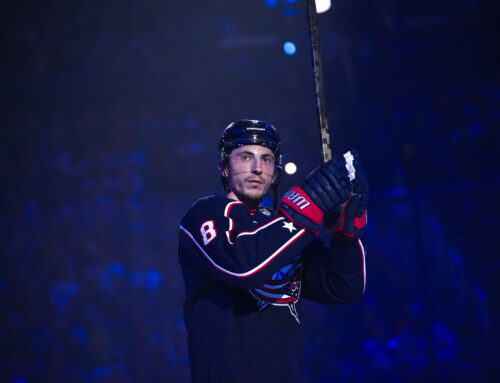
We only had one game on Wednesday night, and no it wasn’t because of Halloween. If my math is right, Game 7 of the World Series would have been yesterday evening had the Los Angeles Dodgers been able to muster some sort of fight. Alas, it was not, and all we had was the lone late game, Chicago in Vancouver.
The Canucks took a 4-2 win from the Blackhawks thanks to a pair of goals from Jake Virtanen. The 22-year old now has five goals in 12 games on the season. He’s shooting a little over 18 percent so that will obviously come down, but he’s also skating under 13 minutes a game. Just be on the look out for him to earn some more ice time soon. Surely, he must.
Patrick Kane was a scratch with an illness.
Brandon Saad scored his third goal of the season, which isn’t a lot for 13 games. Remember, though, how bad his start to the season was. At one point it looked like he might be a healthy scratch and he spent a few games on the fourth line. Of late, he has four points in five games, skating at least 18 minutes in each contest.
*
Let’s get to some news.
Los Angeles announced goalie Jonathan Quick is out indefinitely following surgery for a torn meniscus. In his stead, Jack Campbell would be the pickup to make, if he's available. The rough timeline right now could be up until the middle of December for Quick's recovery.
Thomas Vanek was injured on Tuesday night and left the game. The initial timeline is that he would miss 2-3 weeks with whatever is ailing him. Needless to say, the Wings can ill-afford to lose forward depth. I’m not sure there’s anyone on that roster worth grabbing to fill his minutes.
*
Pekka Rinne was activated off the IR and should be good to go for Nashville’s next game, which comes Thursday in Tampa Bay. The team only has two games in the next six days and only one back to back in the next six weeks so expect Juuse Saros to be on the bench a lot. Maybe they decide to save Rinne a bit, maybe not. I tend to lean in the direction of coaches over-using their starting goalie.
*
Jakub Vrana is once again skating on the top line in practice for the Caps. While they’re going through a rotation of players with Tom Wilson still suspended for the next few weeks, it’ll be interesting to see if Vrana can stick there for the time being. He’s definitely shown well enough to earn longer than a one game look.
*
After missing Tuesday’s game, Kris Letang was back skating with the Penguins on Wednesday, and patrolling the top PP unit to boot. Thankfully, whatever his issue was seems to be very minor and fantasy owners should have nothing to worry about.
For now.
*
File under: “that didn’t take long,” as Mitch Marner was back alongside John Tavares for practice on Wednesday. Kasperi Kapanen was moved down to play with Nazem Kadri.
Not only did Kapanen lose his spot next to Tavares at 5v5, he was also booted off the top PP unit in favour of Patrick Marleau. I do wonder how much line shuffling will go on in the absence of Auston Matthews, particularly if the Leafs aren’t winning as often as Mike Babcock would like.
*
Jake Allen went through the concussion protocol and has apparently been cleared to play. Whether or not the team goes back to the netminder after his start to the season brought an .874 save percentage remains to be seen.
*
Islanders goalie Robin Lehner is being listed as day-to-day. He left Tuesday’s win over Pittsburgh after the second period and did not return. The Islanders goaltender has been a big reason for their early success and they need him back sooner rather than later.
*
Halloween has come and gone and with it, the month of October. It’s hard to believe we’re already four weeks into the season; it feels like it was yesterday the Capitals thoroughly ran over the Bruins in their 7-0 home opener.
We had one game on Halloween, which means this is a perfect opportunity to go over the first four weeks of the season. I’m going to go through trends, hot/cold starts, and differences league-wide from last year. Let’s get right to it and remember, this is up to but not including the late game on Wednesday night and data is from Natural Stat Trick.
The shot rate at five-on-five is down
This might surprise some people given the general speed of the game and the rise in goal scoring, but shot rates at five-on-five are down slightly from this time last year. In 2017-18, teams averaged 57.47 shot attempts per 60 minutes, higher than 2018-19’s rate of 57.29.
I’ll get to goals in a second, but it’s interesting that the overall shot rate has declined. Back in May, I wrote about the increase in league-wide shot rates over the last five years. While 2013 through 2016 didn’t see much change, there was a jump in 2016-17 and a bigger jump in 2017-18. A decline this year would not be in line with the trend we’ve seen of late.
Fantasy owners should take note of this if only for one reason: the need for players to continue to increase their shot rates to maintain their expected fantasy value isn’t necessary. If a guy was projected for 210 shots, and he’s on pace for about 210 shots, then it’s fine. He’s not falling behind in some regard as we might have originally expected.
Goal scoring at five-on-five is also down
Goal scoring is up league-wide on the whole! It’s great! Everyone loves the NHL with a lot of goals!
Except those goals are not coming at five-on-five play. In 2017-18, through to October 31st, teams scored an average of 2.53 goals per 60 minutes at five-on-five, compared to 2.44 goals per 60 minutes this year. That difference has shaved off about 25 goals had the goal rate stayed constant from last year.
Unless you’re in a league that counts just five-on-five goal scoring, that goal scoring in that state is down is not in and of itself very important. What is important is the following…
Goal Scoring on the Power Play is Way Up
Last week in these Ramblings I wrote about how power play efficiency on the season was higher than last year. But that just compared three weeks of the 2018-19 NHL season to the entirety of the 2017-18 NHL season. How did the months of October compare?
Well, it’s not that close. Through to Halloween last year, teams scored 6.9 goals per 60 minutes (nice) with the man advantage. Compare that to this year’s rate of 7.48 goals per 60 minutes and it’s easy to see why scoring is up. That has given us an extra 21 power play goals league-wide through the rise in goal rates alone.
You may have noticed that the 21 extra goals on the PP doesn’t make up for the 25 goals lost at five-on-five. So why is goal scoring up? Other even strength states are picking up the slack. While the decline in goals per 60 minutes at five-on-five is down 0.09 this year compared to last, the decline in goals per 60 minutes at even strength (which includes 4v4 and 3v3) is down just 0.02 goals per 60 minutes. Though there’s been a roughly 25-goal decline at 5v5 compared to this time last year, the decline at even strength – 5v5 + 4v4 + 3v3 – is only about six goals. That is why goal scoring as a whole is up even though the decline at 5v5 is greater than the improvement on the PP.
Short Handed Goals are Down
Just for fun, short handed goals scored per 60 minutes is also down from last year by about 0.13 per 60 minutes. Teams are scoring more on the PP but giving up less.
All this is important for fantasy owners to know. Should trends sustain themselves for the season, having those players who log heavy PP minutes is more important than we thought even a month ago. Less scoring at even strength, particularly at 5v5, and more goal scoring on the PP makes those man-advantage minutes just that much more valuable. Anecdotally, we’re seeing this effect on DraftKings, where defencemen like Neal Pionk and Dennis Cholowski – when on their respective top PP units – have been priced in the same range as someone like Roman Josi.
This puts a premium on some players and reduces the value of others. Keep all this in mind when making trades or adding names off the waiver wire.
*
What do Alex Killorn, Dylan Strome, Pavel Zacha, Colin Miller, and Will Butcher all have in common? None of them have registered a point yet at five-on-five. Their individual points percentage (IPP), or the rate at which they garner a point when a goal is scored with them on the ice, sit at the ol’ Blutarsky: 0.0.
It’s a weird spot for most of these players. Strome’s is understandable as his on-ice goals per 60 minutes is 0.52. In other words, the team has scored one goal with him on the ice at five-on-five this year, with a team shooting percentage of 1.61 percent. Miller’s is low as well at 1.45 goals per 60 minutes, the same rate as Zacha. Killorn’s IPP is 0.00 because the team has scored 0.00 goals per 60 minutes with him on the ice. However, the New Jersey Devils have scored 2.93 goals per 60 minutes with Butcher on the ice and he has yet to register a point.
There’s nothing really out of line for the Devils. They’re shooting 8.8% as a team at 5v5, sitting at 10th in the league, scoring 2.79 goals per 60 minutes. That puts Butcher’s on-ice goals at a normal level. Had he registered a point on 41% of the goal scored with him on the ice this year as he did last year, you could add 2-3 points to his current total.
All this is to say I think it’s worth poking your league’s Will Butcher owner, but in a points-only league rather than a roto league and see what it’d cost to acquire him. He won’t contribute much in shots or other peripherals, but 40 points should be seen as his floor right now, rather than a level owners hope he can reach.





 FLA
FLA EDM
EDM NYR
NYR CGY
CGY MIN
MIN SEA
SEA
